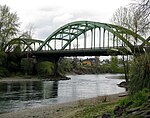John McLoughlin Bridge
1933 establishments in OregonBridges by Conde McCulloughBridges completed in 1933Bridges in Clackamas County, OregonBridges of the United States Numbered Highway System ... and 10 more
Buildings and structures in Oregon City, OregonGladstone, OregonOregon building and structure stubsOregon transportation stubsRoad bridges in OregonSteel bridges in the United StatesTied arch bridges in the United StatesU.S. Route 99United States Numbered Highways stubsWestern United States bridge (structure) stubs

The John McLoughlin Bridge is a tied-arch bridge that spans the Clackamas River between Oregon City and Gladstone, Oregon, in the northwest United States. It was designed by Conde McCullough, and named for Dr. John McLoughlin. It is 720 ft (220 m) long, with a main span of 240 ft (73 m). The deck carries four lanes (two in each direction) of Oregon Route 99E, also known locally as McLoughlin Boulevard. The bridge won the American Institute of Steel Construction's title of "Most Beautiful Steel Bridge" constructed in 1933. Originally painted black, it was painted "ODOT Green" soon after, the first time that specific color was used on a bridge.
Excerpt from the Wikipedia article John McLoughlin Bridge (License: CC BY-SA 3.0, Authors, Images).John McLoughlin Bridge
McLoughlin Boulevard,
Geographical coordinates (GPS) Address External links Nearby Places Show on map
Geographical coordinates (GPS)
| Latitude | Longitude |
|---|---|
| N 45.37322 ° | E -122.60143 ° |
Address
John McLoughlin Bridge
McLoughlin Boulevard
97027
Oregon, United States
Open on Google Maps






